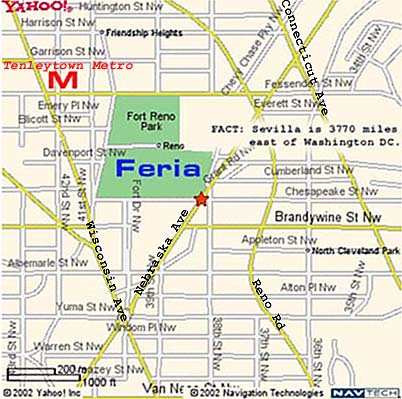
|
Introducing Ulrika FrankSunday October 24, 2004 Dancer/teacher/choreographer Ulrika Frank recently arrived in the DC area from Atlanta. She brings with her a wealth of experience both as a performer and a teacher. Currently she teaches at Joy of Motion in Friendship Heights and privately in her home in Vienna, Virginia. She was kind enough to take time out of her busy schedule for this brief interview: Miguelito: I noticed in your bio that you studied anatomy, dance method, pedagogy, etc. What are some of the applications of your knowledge of those subjects, that you use in teaching of flamenco dance? For example, one of your students mentioned to me that for arm movements you have an exercise called the "crab," can you elaborate? 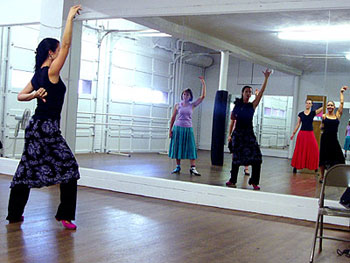 Ulrika: During my years at National College of Dance in Stockholm, Sweden, we studied, besides the dancing, anatomy, dance method, pedagogy, etc., that are all essential to the art of teaching, which I really do believe is an art form itself. The more knowledge you have physically about what really is happening in the body when you are dancing, what muscles are used in a particular movement, or how to strengthen certain parts of the body, the better you as a teacher will be able to help the student to improve his/her dance technique. Especially since dancing, according to my belief, is all about feelings shown through body awareness, which leads to the other approach to teaching. Dance method and pedagogy helps you realize that we are all different, and therefore need to be taught differently ~ one single method is not for everybody. For example, some students cannot get a step if you are only counting, but if you instead sing the rhythm, it works perfectly. Same thing using anatomy terms explaining e.g. an arm movement, it is like Greek to some. But, if you use an image of a "flamenco crab" holding the shoulder blade down so the arm extends upwards without the shoulder rising and shortening the neck line, then there is no problem. [Editor's note: see photo for an illustration of this concept] After some years of teaching, you learn to "scan" people, to see what teaching method fits that person the best. To me, that is the challenging beauty of teaching dance. M: All of us non-Spaniards have our interesting stories about how we got into flamenco. What's your story? U: First of all, I got into dancing by a true coincidence. I had left my hometown for Stockholm to become a hair dresser (yes, I am a qualified hair dresser!), but the first week there, I had to stay with a friend of a friend, a girl who was absolutely mad about dancing and had her goal set to become a musical star! She took me to jazz and modern dance classes, and that is how I started. After three years, I decided to leave the hair salon I was working at, an easy choice, and I auditioned for a 1-year dance course. During that course something happened that would change my life forever; a woman and a guitarist came to teach flamenco for one week. Wow...I fell in love! Not with the guitarist [laughter] but with the rhythms! I was mesmerized and truly challenged, because I thought it was really hard in the beginning. From those days and on, it has been all about dancing for me; modern and jazz but especially flamenco. I soon discovered that flamenco demanded so much more from me in terms of understanding an entire art form, that the singing and the music were equally important as the dancing. That is what I love about the flamenco, to try to unite these components into one whole. (The girl I stayed with? She has a "normal" job and family and she does not dance!) M: What or who are your sources of artistic inspiration? U: The years at National College of Dance, earning my BFA in dance, and following scholarships, gave me the opportunity to study in Spain which is the no. 1 recommendation to everyone who wants to study flamenco at a higher level. Just to be there, to meet other flamencos, take classes every day, go to shows every week, to be part of a flamenco crowd, to not have to worry about anything else than flamenco - besides how to make your last pesetas cover rent when you already have spent every dime on flamenco shows, shoes, costumes and classes - is my most inspiring source to dance. Then, there is of course an immense source of incredible flamenco artists who have all made deep and long lasting impressions, such as Eva la Yerbabüena and Andrés Marin, Manolo Sanlúcar and Chicuelo, Miguel Poveda and Remedios Amaya. M: Most dance teachers teach more choreography than technique and some vice-versa. What's your philosophy on this? 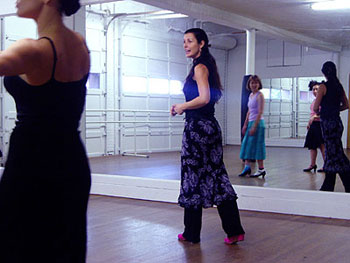 U: I prefer to separate the two, but then it has to be set beforehand, so everyone knows what to expect from class. You need technique to dance a choreography, it comes hand in hand, simple as that, but the danger I see in only teaching choreographies, is that some students think that if they can learn and perform a Tangos for example, then they know all they need to know about Tangos, which is not the case. Of course, it is important to learn the actual steps or routine but what really is important is to learn the structure, so you can use those steps and quickly reconstruct your routine to any Tangos music, live or recorded. I think it is very necessary with technique classes, where you can focus mainly on how to use the body so it knows what to do in a choreography, and not only on feet, but arms, turns and upper body as well. I also think it benefits the students to not have to deal with the artistic approach, since dealing with technique alone is sometimes more than enough. All of the above, is more geared towards the beginner and intermediate level students, even if they definitely also need to be "spiced up" with some choreographies, to see what it is really like, because at a more advanced level you already have the technique and can start right away with choreographies. To separate the two classes, gives me more time to concentrate on one or the other and better prepare the students for an advanced level. M: Has your previous "stage" experience as a fashion model helped you develop as a flamenco performer? U:Yes. Everything you do in public, in front of a camera or on a small or big stage, whether it is arts, speaking at the local library, do a presentation at work, teach a class, etc, helps you to leave "the personal you" at home, and get into a different role and be able to present "the little extra you" which is needed on stage: the one who glows in a very special way because you have added some shiny sprinkles on your common self, but still is you underneath. M: What are some of the ways you help your students bridge the gap from just going through the motions to truly expressing themselves through dance? 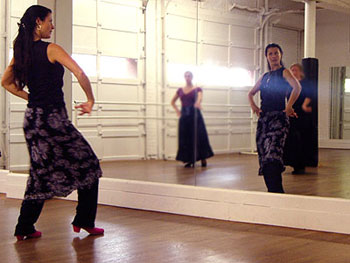 U: Belief and respect! You have to believe in, and respect, your students to give them confidence to express themselves. For instance, when I founded Perla Flamenca in Atlanta, it was founded first of all because I believed in them, I believed that they could do it. It takes a lot of courage to be a student and it requires an equal amount of encouragement from the teacher to help him/her get comfortable enough to dare to try. As a teacher, it is good to look back at when you started yourself, and remember how it felt standing there at class knowing nothing, how it felt the first time on stage. I believe that teaching is like performing in one way, and if the students see that you give it all at class, they will, too, eventually. M: Some students study flamenco purely for recreation and some have professional/semi-professional aspirations. How do you address these different goals in class and keep the class as a whole progressing? U: I try to have my "back pack" of steps filled with all kind of solutions for all kinds of people and situations. For example, add a more difficult ending or an extra turn to those who need an extra challenge, or tell the less advanced student that it is okay to make the step in half speed or to not do the arms in combination with the feet. Of course, there are times where you simply need to ask a student to consider changing level, lower or higher, both for the sake of that person and the group. If a student really wants to be a professional, he/she needs to, besides spending a lot of time practicing alone, either join a company or take private classes, because you can never achieve the same focus and concentration at general classes, unless it is a class you have auditioned for, such as a repertoire class. M: What are your short term/long term plans for your flamenco career here in the Washington DC area? (Some people are wondering if you plan to start a dance company.) U: Hmmm...I hardly know myself! What I do know is that I need to dance flamenco, my greatest passion in life! The stage is the one place where I feel really at home. I have put on my own productions, such as Flamenco Con Gusto this past spring in Atlanta with invited artists, and I hope to do the same here - if I find "la plata." In due time, I would like to start a company here, as in Atlanta, something I truly enjoyed. Besos a las Perlas! M: Based on your short time here so far, what are your impressions of the DC flamenco community? What do you see as our strengths and what about our areas for improvement? U: I have met so many nice DC flamenco people, who have all been so good to me, thank you! I am impressed by the community and how you manage to keep it so "kicking and alive". Since I was part of building the community in Atlanta, I know what it takes. You have a wonderful group of dancers, musicians and aficionados here, that you should be very proud of. As far as I am concerned, I see no areas for improvement, and even if there were, I am far too new in this community to be the one to ask for advice. M: Where are you teaching? Where can we get more information about you? U: I am teaching general classes at Joy of Motion, Friendship Heights in DC, on Thursdays and Saturdays, and private classes at Casita Flamenca, my home studio. Please visit my web site for more information about me and my classes at www.frankflamenco.com I would like to give a special thanks to Michael Perez for doing this interview. ¡Que Viva el Flamenco! [Editor's note: this is the first of a series of interviews with local flamenco teachers. I don't know how long it will take but eventually I hope to interview all the local teachers in the DC area.] Duende at the DC Dance CollectiveFlamenco Workshop with "La Tati," Madrid’s flamenco dancer! Friday July 16, 2004 Francisca Sadornil Ruiz, known throughout the world as “La Tati,” represents the very core of passion and virtuosity that is flamenco. With a career spanning over forty years, she is well-known to flamenco aficionados, as a dancer, teacher, choreographer and theatrical producer of works that suffuse flamenco, poetry, and drama. “La Tati” is a great inventor – of her life as well as the art in which she has labored with love and vitality – a powerful presence not be missed. Well-known as one of the most influential flamenco teachers in Madrid, local students will have the opportunity to experience her unique teaching style. From August 27 through September 5, 2004 La Tati will be giving a workshop at the DC Dance Collective on Wisconsin Ave. Students desiring to build on the two recent flamenco workshops given by the mystical “La Truco” and the luminous Carmela Greco, and to deepen their understanding and polish technical skills, will have another, stellar opportunity to do so. For flamenco artists and teachers, as well as students in the DC area, La Tati brings a unique excitement along with her instruction, which is rigorous but also accented by a rich personality and inflected with humor. Aside from a challenging workout and putting even the most advanced dancers’ skills to the test, what can one expect during “La Tati’s” instruction in Washington? Local artists say: “…I had been dancing flamenco for less than one year, so I was a bit nervous that Tati’s workshop would be too difficult… She encouraged us with her endless energy and inspired us with her singing, teaching steps by constant repetition. By the end of the week we were dancing a fantastic Bulerias, some of which I still use to this day …” Kyoko “Tati is one of the legends of Flamenco.....She is so special she borders on the spiritual Although you may not be aware of it at the time, the very repetitive nature of her teaching technique assures that you come away with a fuller understanding of what flamenco is, how it works, and where you are going with it. She does not just teach steps, she teaches the process by which flamenco evolves. She is very flamenca and equally a good teacher for a man as for a woman.” Natalia Monteleon “…La Tati’s teaching method focuses on … minute details of body movement and rhythm. Her energy and the duende that permeates her entire being also create an atmosphere of sheer inspiration. … Though it helps to have done some footwork and have basic understanding of compas, her technique instruction is for dancers at all levels …I strongly encourage everyone who’s studied for a year or more to take this workshop … you will be grateful you did.” Aleksey Kulikov Besides instruction in technique for beginning/intermediate students and choreography for advanced dancers, the workshop encourages one to drink in the personality of a remarkable woman whose artistry is legend. One cannot hope for a more compelling chance to partake of that legend. Kivanc needs our help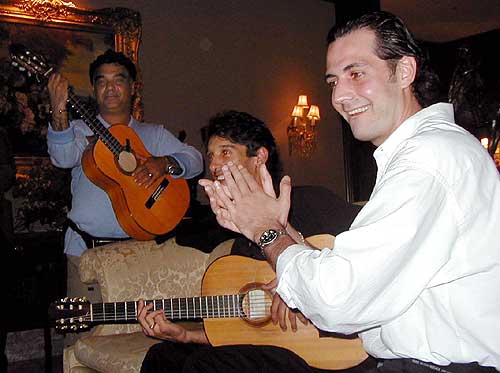 Friday July 16, 2004 Kivanc Oner is a well-known local flamenco musician in area. Up until last summer, you could have heard his music played at the waterfront in Georgetown. He played at Chi Cha Lounge, Meze, Bambule, Sesto Senso, and many other places. Only last year, Kivanc was diagnosed with Hodgkins Lymphoma. He has been undergoing chemotherapy, but it has not been able destroy the cancer cells. His doctors have determined that his best chance at beating this disease is to have a bone marrow transplant. In an effort to help, his family and his friends have been trying raise money for his cause. Any donation, big or small, would be appreciated. Kivanc's account information is as follows: If you prefer to send a check, the address is as follows: If you prefer to make a credit card payment, click on this link If you are interested in learning more about him and his music, please visit his website @ www.kivanconer.com Thanks again for your help. The DC Feria is THIS Sunday!Tuesday June 1, 2004 It's the biggest local flamenco event for the DC community. The DC Feria is on Sunday June 6th from about 12:00pm to 6:00pm at Fort Reno Park near the Tenleytown metro {see map). Admission is FREE! While many people may go to enjoy the free performances by several of the local flamenco groups, I just want to alert you to other things worth checking out: 
2. SHOPPING! Usually there are several vendors selling flamenco and Spanish-related products. TIP: bring sufficient cash because there are no ATM's nearby. Practice your bargaining skills.
3. PARTIES! 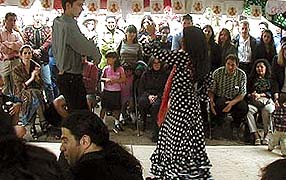  Additional tips: Additional tips:
DON'T FORGET: The night before the DC Feria is the unofficial Annual Pre-Feria party which be held at Bon Appetito restaurant 4907 Wisconsin Ave NW DC (202-966-1600) across the street from the DC Dance Collective on Saturday June 5th 10:00pm-ish. Yeah, it's just an excuse for another flamenco party, but it's really meant to be an opportunity for visiting flamencos to hang out with the locals. It's also a welcome party for Carmela Greco who's giving a workshop at DC Dance Collective--the class gets out at 10:15pm-ish. If the party gets too big for Bon Appetito, we can always walk down the street to Villa Tuscana. In the meantime, here are some pics from the Pre-Feria party from 2000. Letter from Virginia BeachTuesday June 1, 2004 In an email dated May 20th, Virginia Beach-based dancer/teacher/choreographer Vicky Flores Cooke writes:
Interview with Carmela Greco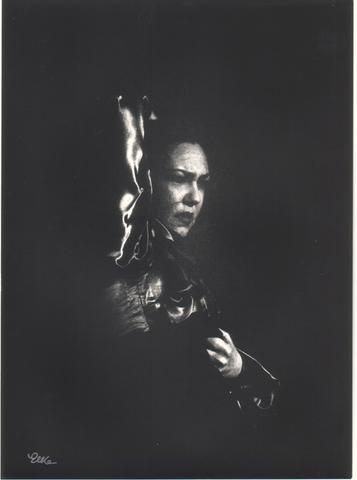 Friday May 21, 2004 Next month, Carmela's passing through DC to give a workshop. Local dance student and workshop organizer Nicole Totah interviewed Carmela (and also translated into English for publication here). Thanks Nicole! What do you plan to teach in the upcoming DC workshop? Oftentimes in flamenco workshops, I see a focus on feet (taconeo) and steps (pasos). In these upcoming workshops in June, we are going to do something a little different: We are going to focus on the use, movement and form of the whole body, with a particular emphasis on the upper body, to interpret the music and to express the sentiment in the music. We are going to look at the torso, shoulders, arms, hands, and fingers in particular palos and determine how each dancer can use these instruments to fill up the space that surrounds them. That being said as an overarching theme, there are going to be two levels of workshops and each workshop will focus on different material. In the Advanced Beginner/Intermediate level, we are going to work on the different flamenco rhythms—the 12-count, the ¾ count, and the seguidillas. Should time allow, I’d also like to focus on concepts such as the “remate” and how to know when to do a “remate,” and some choreography for seguidillas which can serve as a basis for focus on the upper body. In the Intermediate/Advanced level, we are going to work on the Guajiras with a fan, focusing on such concepts as how to use space and how to move the body in the Guajiras and how to move the fan in the compas of the Guajiras, which is a special palo with a special compas and a unique style. All of this talk reminds me: To all those coming, or planning to come to the Intermediate/Advanced level, bring a fan with you! Who/What has helped to shape and form you as a dancer? Many people have helped me, but who gave me my basis? It was my parents, since I was a child. I remember when I was very young and they were practicing in one room, I would often be in the room next door dancing on my own to their rehearsal music. Because of my parents’ example, I already had a concept of what it was to dance at a young age. What inspires you to dance? What inspires you when you dance? Love, sadness, hate, nature—even a lone flower….everything, everything inspires me in some way to dance. We could be here all afternoon talking about this… Really, the most powerful emotion for me is sadness. When I feel sadness—conveyed and catalyzed through the music and the cante, particularly the cante, which for me is so important—I am able to express many events and experiences of my life. I dance when I’m happy, I dance when I’m in love, but I’ve noticed that when I’m sad and I dance, something opens up inside me and pours out through my body. Who do you want to be, professionally-speaking? I want to be completely honest, with myself and with others…If there is one person I want to emulate, it is my father [Jose Greco]. I admire so many aspects of his person, both personally and professionally: His energy, his knowledge, his struggle, and his behavior towards art, dance and life. I will never be all the things that were my father, but every day I try…and I think that in certain ways, I have succeeded. In your opinion, what should be the focus for a student of flamenco? The most important thing for a student of flamenco is understanding the rhythm, or the compas. Without compas, nobody can dance flamenco. And it’s important to not only know the compas in your mind, that is, theoretically understand how to count the compas, it’s important to know and feel the compas in your body and to know when to stop dancing in the compas. You know how I know when a student knows the compas….when they know when to stop. What do you see happening in flamenco in Spain today? In other countries? What do you see happening in the future? In Spain, the level of flamenco is very good. But—and I say this qualifying that it is my personal opinion—teaching at certain times, in certain places, can be misdirected. The reason that I say “misdirected” is because some new techniques which endeavor to bring fusion into flamenco stray from the roots of flamenco and label as “flamenco” movement that has very little, if anything, to do with flamenco. I am not against fusion in flamenco and I am not a flamenco purist; rather, I believe that each flamenco dancer can do what they want, so long as they stay true to, and respect the roots of, flamenco. In my past and through the present, I have danced flamenco non-traditionally, with more open lines, but I always respect what is flamenco and I maintain the style of flamenco even in movements that are not purely flamenco ….I believe that in order to stay true to the purity of flamenco, you must have a clear idea of what it is and what it means, otherwise how can you respect it? Flamenco is difficult. There are many ways to come to flamenco, but there is only one flamenco. You ask me about the future….I am somewhat worried about the future of flamenco, but I do trust that somehow, some way, flamenco is going to return to re-take and embrace its roots. [Editor's note: for more information on the workshop visit my Special Events Page.] Sala Rociera...it's the students' turn!Sunday February 22, 2004 It's about time the students have their own flamenco party. I'm sure you've heard about the flamenco parties that go on in the DC area where the local performers get together and jam for hours and hours. But let's face it. It can be intimidating when the students that go to these parties feel inspired to get up and do their flamenco thing but usually end up sitting on their butts instead, thinking to themselves, "I'm not going to dance in front of these professionals!" Talk to any of these "professionals" however, and most will admit that they are in fact still students, in the lifelong sense. They still take classes with their peers in Spain. But here in DC they learn so much from these parties. Huh? Parties are educational? Now you ask, "What can one expect to get out of a flamenco jam session?" For one thing, you get an idea of what flamenco was originally intended for: according to Claus Schreiner's introductory chapter to Flamenco (Amadeus Press 1990) page 22, "..the cante and its lyrics allowed them [the gypsies] to maintain their freedom of personal expression in a grito desgarrado (heart-rending cry)." Later Claus continues (page 23): "Rather than thunderous applause by a large crowd, flamenco seeks direct communication with a small group, in which each individual comes to feel that he is being personally addressed." I assume that most of us have never experienced life as a gypsy, but still, I know for a fact that flamenco touches all of us very deeply in some way that cries to be let out. Well, students, now it's your turn to get a taste for this experience in a non-intimidating environment. This coming Friday February 27th, a number of my flamenco friends have organized a flamenco party just for you. What that means is that none of the local pros will be performing. It's just students sharing their "inner cry for flamenco" with other students. Details from the press release: Sala Rociera featuring: Juerga Flamenca at
Mediterranean Cafe
This night is dedicated to all students that would like to come and have a good time. However, your non-flamenco friends are welcome. Mediterranean Café is located at 4629 41st St NW DC 20016 Map. Juerga from 9:00pm until closing. Cover $10 includes a drink. See you there! OK, so you ask, "What really is Sala Rociera?" Local ethnomusicologist Gerard Moreno writes: "The Sala Rocieras are a direct response to the flourishing celebration throughout Spain, and especially Andalusia, of the romeria (pilgrimage), of the "Virgen del Rocio." Each year, eight weeks after Pentacost, up to 250,000 people make their way to the little town of El Rocio, to pay homage to the "Blanca Paloma," as the Virgen del Rocio is also known. The people go by horseback, by wagon trains,and by especially made mobile homes called "Caretas," which are pulled by tractors." "The only way to go El Rocio for the Romeria is to be a member or guest of one of the one-hundred brotherhoods or "Hermandades" scattered throughout Spain whose sole purpose is to organize their part in the pilgrimage. Many of these brotherhoods are over three hundred years old. Each brotherhood will be composed of hundreds of pilgrims and involve hundreds, even thousands of animals, such as horses, mules, cows and oxen, not to mention the food they must bring with them, the wagons or carretas they will sleep in, and of course, the manzanilla and beer they will drink! In Andalusian Catholicism, there is a place in theirr devotion and worship for wine, dance and song." "Which brings us back to the Sala Rocieras. As one can imagine, the logistics involved in preparing for the romeria is, for each Hermandad, enormous. The work goes on all year. All the symbolic stops with their ceremonies, the food for the livestock, the campgrounds, etc. have to be planned to the most minute detail. For many Rocieros, the Rocio becomes, as Flamenco to many Flamencos, "A way of life." No sooner have they finished one Romeria, that they are planning the next. To do the planning, most Hermandades have a meeting hall, be it a local bar owned by a member, a space in a local parish, or a hall especially reserved, or more oftern, owned by the Hermandad. At the meetings, which go on all year long, they not only plan logistics and socialize, but they practice their singing and dancing from the enormous repertoire of Sevillanas and Fandangos Rocieros. It is actually quite amazing when one realizes what a large precentage of the entire repertoire of Sevillanas and Fandangos refer to the Rocio. In fact, throughout Andalusia, almost every record store will have not only ia section reserved for Sevillanas, but within the Sevillanas secition there is a large space devoted to Rociero recordings. Many new Sevillanas Rocieros are composed each year, and often performed for the first time at the local Sala Rociera to which the composers and performers belong." "Although Sevillanas by far dominate the music of the Rocio, there is also a body of beautiful songs to the Virgin called "Salve Maria's." Each Hermandad will sing the Salve Maria they prefer, and will sing this particular one at each mass along the pilgrimage, and at each important stop along the highly symbolic journey. Like the Sevillanas, and the Fandangos, these Salve Maria's are also being newly composed and find their way into the popular Andalusian culture. At this time the very popular Salve Maria "del Ole y Ole" can be heard throughout Spain." "But each Hermandad had to begin somewhere, and often they started out as associations of people who had been to, or wanted to go to, the Rocio. At the Sala Rocieras people come together to dance Sevillanas, Fandangos, and even Rumbas, as well as to learn the newest compostions and styles, or to present their own compositions." "But there are Sala Rocieras, and Coros (choruses) Rocieras, from as far away as Santiago de Chile and even Belgium, so why not Washington Dc? Which brings us to this coming Friday with Edwin Aparicio at the Mediterranean Cafe in Georgetown. Be there. Sevillanas is its own musical culture, parallel and even overlapping, but distinct nonetheless from Flamenco. To the non-Spaniard Flamencos of Washington DC, Edwin's Sala Rociera will afford a new appreciation of the Sevillanas." Thanks Gerard! There will be a test on this later. :) In the meantime, come out this Friday and have some flamenco fun! Vote "YES FOR CANTE!"Friday January 16, 2004 Imagine this hypothetical conversation between flamenco festival producers and concert presenters: "OK, so let's talk about the artists we'll be featuring in the Flamenco Festival for 2005." "Allright. We'll get Dance Company A and Dance Company B and let's also add Guitarist C. And let's not forget our opening night Gala." [One or two hours of discussion...] "Great, we're done. That was easy!" "Hold on, what about a cante concert?" "Bad idea. We had to cancel a few cante concerts last year because of low ticket sales. Those Americans just don't appreciate cante." Again, that was just a hypothetical conversation, but it could happen. Word has it that the upcoming Jose Merce concert on February 4th could use more ticket sales. The truth is that we flamenco aficionados only make up a fraction of the audience at flamenco concerts. The majority, I imagine, are generally people who have heard about flamenco but only go as far as appreciating the most accessible aspects: baile (dance) and toque (guitar). Our enthusiasm, knowledge and appreciation, in our minds, might make up for the empty seats, but the future of cante concerts is still dependent on ticket sales. Perhaps we can copy what they're doing up at the Chicago flamenco festival where some of the concerts are subsidized to the point that admission is free! My friend Victoria Odinotska writes: "First of all, I think that D.C. flamenco community must be a favorite of Lady Luck, which sent us within the last several months three of the biggest cante masters Spain has to offer these days: Carmen Linares, Enrique Morente, and Jose Merce. All of them are wildly popular in Spain and it's extremely hard to get tickets to their concerts at home (I tried to see Morente last year in Sevilla, but it was all sold out)." "And what do we in Washington do with this luck? We ignore it (i.e. we couldn't fill even the tiny Lisner auditorium, with 1500 seats, for the truly phenomenal and legendary Morente!) That is a really bad reflection on us flamenco lovers here. I truly believe that listening to great cante will teach a dancer as much as taking dance classes. (I am, of course, not a dancer, but desperately want to be one when I listen to flamenco:)! After all, it's not just technique and choreography, its the singer's deep feelings, voice and music that sets the dancer's heart on fire. No?" "Cante just seems to be the most rare and difficult art of all. I read somewhere (and I hope I remember it correctly) that to be a great tocaor, you have to study guitar in Spain, to be a great bailaor, you have to be a Spaniard, but to be a great cantaor, you must be an Andalucian gypsy. Cante is this unique. (Although D.C. have been successfully contesting this belief by producing some outstanding guitarists, dancers and singers!!!:). Throughout the history, they have said that cante is flamenco's source of inspiration. Its beauty may not be as easy to recognize as dance, but those who listen often make a great discovery for themselves." "Mike, you are so right in saying that to be able to experience top artists in DC for the future, we need to support Lisner Auditorium's efforts as much as we can, RIGHT NOW. Otherwise, we may not get that lucky again. It's very major to get Jose Merce to come here. He is as big as it gets in modern flamenco -- a great performer who does it all -- from cante jondo to easy nuevo flamenco-style. And he managed to acquire huge commercial success while doing it, producing a platinum CD. Some call him the Camaron of today for his efforts to keep flamenco in the modern life. Like Camaron, he makes it easy to understand and enjoy his music. His CDs have been at the top of the charts in Spain." "Please do yourself a favor and buy your tickets for the Jose Merce concert now -- together with outstanding guitarist, Moraito, he would make an unforgettable impression on you. And try to bring a friend along to fill another seat in the audience. I promise to bring two (or at least buy them the tickets:)." "Thanks again, Mike for keeping us 'in the know.' Best regards and Happy New Year!" Victoria. Thanks for the encouraging words of support Victoria. The future of DC area cante concerts is at stake here. Please vote YES FOR CANTE by buying your Jose Merce tickets and encouraging others to do the same. End of sermon. :) [earlier articles][later articles][main index] |

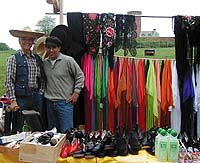 TIP: get to the Feria early and do a quick reconaissance of the kiosks
to see what dishes are being prepared. Locate the kiosks that will be
serving what you want and as soon as the food is ready, get in line
quickly!
TIP: get to the Feria early and do a quick reconaissance of the kiosks
to see what dishes are being prepared. Locate the kiosks that will be
serving what you want and as soon as the food is ready, get in line
quickly!